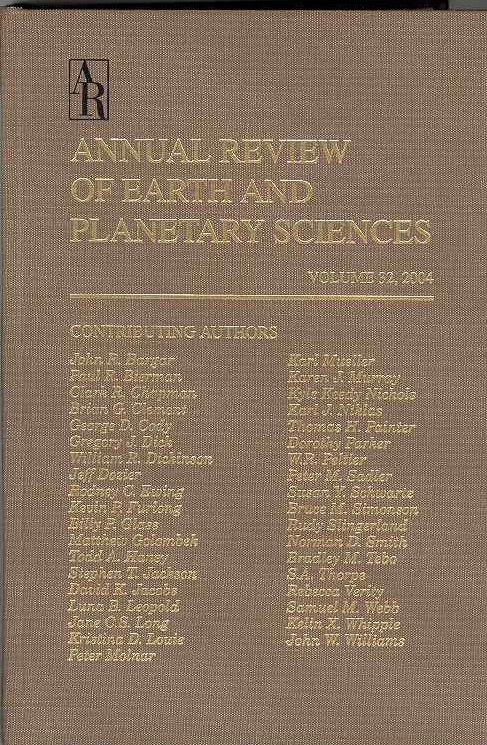过去和未来的气体:甲烷在地球进化中的多功能作用和作为生物标志的潜力
IF 13
1区 地球科学
Q1 ASTRONOMY & ASTROPHYSICS
Annual Review of Earth and Planetary Sciences
Pub Date : 2025-02-04
DOI:10.1146/annurev-earth-040523-124821
引用次数: 0
摘要
甲烷(CH4)是一种简单的分子,由于它的辐射强迫,对行星的热平衡产生了巨大的影响。甲烷是在一系列压力和温度下通过多种非生物途径形成的。厌氧呼吸的生物产甲烷作用使用末端含镍酶,并且仅限于古细菌的生命领域。甲烷也可以在细菌甲基膦酸盐和甲胺降解过程中由好氧微生物产生,也可以在氧化应激过程中通过非酶反应产生。非生物CH4是通过产热反应和在金属催化剂存在下的蛇纹石化反应产生的。重建地质时期的甲烷循环在很大程度上是推断性的。纵观地球历史,甲烷可能是仅次于二氧化碳的第二重要的温室气体。在过去的~ 35亿年里,生物甲烷生成可能主导了进入地球大气的CH4通量,在此期间,CH4被认为随着大气氧气的增加而普遍下降。在这里,我们回顾了CH4循环在地球历史上的演变,展示了CH4在地球气候、益生元化学和微生物代谢中发挥的多功能作用。我们还讨论了地球大气CH4的未来,CH4在太阳系其他行星体(特别强调土卫六)上的循环,以及CH4在类地系外行星上作为生物特征的潜力。▪在地球上出现生命之前,地球早期大气中丰富的CH4可能是建立可居住条件和产生生命前化学有机分子的关键。▪厌氧呼吸的生物产甲烷只存在于一些厌氧古菌群中,但CH4也可以通过酶和非酶生物途径产生,这些途径与能量节约没有直接联系。这些途径对全球CH4循环的相对重要性是一个活跃的研究课题,但古细菌甲烷生成在所有其他生物途径中占主导地位。▪随着地球历史上大气中O2的增加,模式显示大气中CH4的减少;在遥远的去氧未来,大气CH4预计将再次上升。▪未来的土卫六任务将有助于了解太阳系中唯一一个存在活跃甲烷循环的行星体上复杂的有机化学。本文章由计算机程序翻译,如有差异,请以英文原文为准。
The Once and Future Gas: Methane's Multifunctional Roles in Earth's Evolution and Potential as a Biosignature
Methane (CH4 ) is a simple molecule that, due to its radiative forcing, wields an outsized impact on planetary heat balance. Methane is formed by diverse abiotic pathways across a range of pressures and temperatures. Biological methanogenesis for anaerobic respiration uses a terminal nickel-containing enzyme and is limited to the archaeal domain of life. Methane can also be produced in aerobic microbes during bacterial methylphosphonate and methylamine degradation and via nonenzymatic reactions during oxidative stress. Abiotic CH4 is produced via thermogenic reactions and during serpentinization reactions in the presence of metal catalysts. Reconstructions of methane cycling over geologic time are largely inferential. Throughout Earth's history, methane has probably been the second most important climate-forcing greenhouse gas after carbon dioxide. Biological methanogenesis has likely dominated CH4 flux to Earth's atmosphere for the past ∼3.5 billion years, during which time CH4 is thought to have generally declined as atmospheric oxygen has risen. Here we review the evolution of the CH4 cycle over Earth's history, showcasing the multifunctional roles CH4 has played in Earth's climate, prebiotic chemistry, and microbial metabolisms. We also discuss the future of Earth's atmospheric CH4 , the cycling of CH4 on other planetary bodies in the Solar System (with special emphasis on Titan), and the potential of CH4 as a biosignature on Earth-like extrasolar planets. ▪ Before life arose on Earth, abundant atmospheric CH4 in Earth's early atmosphere was likely key for establishment of habitable conditions and production of organic molecules for prebiotic chemistry. ▪ Biological methanogenesis for anaerobic respiration is only known to exist in some groups of anaerobic archaea, but CH4 can also be produced via enzymatic and nonenzymatic biological pathways that are not directly coupled to energy conservation. The relative importance of each of these pathways to the global CH4 cycle is a topic of active research, but archaeal methanogenesis dominates all other biological pathways for CH4 generation. ▪ As atmospheric O2 rose over Earth history, models suggest that atmospheric CH4 declined; in the distant deoxygenated future, atmospheric CH4 is predicted to rise again. ▪ Future missions to Titan will aid in understanding the complex organic chemistry on the only other planetary body in our Solar System with an active methane cycle.
求助全文
通过发布文献求助,成功后即可免费获取论文全文。
去求助
来源期刊

Annual Review of Earth and Planetary Sciences
地学天文-地球科学综合
CiteScore
25.10
自引率
0.00%
发文量
25
期刊介绍:
Since its establishment in 1973, the Annual Review of Earth and Planetary Sciences has been dedicated to providing comprehensive coverage of advancements in the field. This esteemed publication examines various aspects of earth and planetary sciences, encompassing climate, environment, geological hazards, planet formation, and the evolution of life. To ensure wider accessibility, the latest volume of the journal has transitioned from a gated model to open access through the Subscribe to Open program by Annual Reviews. Consequently, all articles published in this volume are now available under the Creative Commons Attribution (CC BY) license.
 求助内容:
求助内容: 应助结果提醒方式:
应助结果提醒方式:


